The Royal Navy frigates, HMS Lancaster and Westminster, tanker RFA Tiderace and vessels from Estonia, Latvia and Lithuania have joined forces in the UK-led Joint Expeditionary Force.
It is the first operation of the UK-led Joint Expeditionary Force – a partnership of nine northern European nations committed to working together on operations as varied as warfighting through to humanitarian assistance and defence engagement, the UK’s defence ministry said in a statement.
“In this instance, the expeditionary force is focusing on maritime security in the southern Baltic Sea”.

The Royal Navy ships have been joined by the Estonian minehunter, Wambola, the Latvian patrol vessel, Jelgava, the Lithuanian minehunter, Jotvingis and the patrol ship, Selis.
Testing collective seamanship in sub-zero temperatures
“Some of the UK’s closest and most steadfast allies are found in the Baltics. This deployment is both the latest example of a long and proud history of defence cooperation and a clear demonstration of the capability of the UK-led Joint Expeditionary Force,” Ben Wallace, the British defence secretary, said in a statement.

The ministry said the ships had conducted “a series of combined manoeuvres to test collective seamanship and get used to working together as a united task group, all played out in unrelenting sub-zero temperatures”.
“The weather in the Baltic in March – glorious sunshine one minute and a few hours later the aircraft is flying through snow squalls – is placing demands on the aircrew as well as the engineers maintaining the helicopter”.

“HMS Lancaster’s Wildcat helicopter is flying patrols by day and night, in particular making use of its cutting-edge thermal imaging camera to refine identifying shipping in the Baltic, as well as practising secondary duties such as search and rescue and winching,” the UK’s defence ministry said.
The Queen’s Frigate leading the way
The 4,900-ton HMS Lancaster and HMS Westminster are the Type 23 frigates of the Royal Navy, launched in 1990 and 1992, respectively. The HMS Lancaster is known as “The Queen’s Frigate”, the Duke of Lancaster being a subsidiary title of the Sovereign. The 37,000-ton RFA Tiderace is a Tide-class replenishment tanker of the British Royal Fleet Auxiliary, launched in 2015.
The Estonian Navy ship, Wambola, was originally built as a minelayer in 1977 for the Danish Navy and named Lossen. In 2009, she was handed over to the Estonian Navy as a command and support vessel and renamed Wambola.

The Latvian Navy’s Jelgava, launched in 2013, is one of the country’s five Skrunda class patrol vessels.
The Lithuanian minehunter, Jotvingis, was originally a Royal Norwegian Navy minelayer and command vessel, launched in 1977 as Vidar. Lithuanian patrol ship Selis, launched in 1988, previously served the Danish Navy; it was transferred to the Lithuanian Navy in 2016.
Cover: HMS Lancaster takes part in a close proximity navigation exercise in the Baltic Sea with Lithuanian ship LNS Jotvingus (top), and Latvian Ship LVNS Jelgava (middle). Photos by the Royal Navy.

